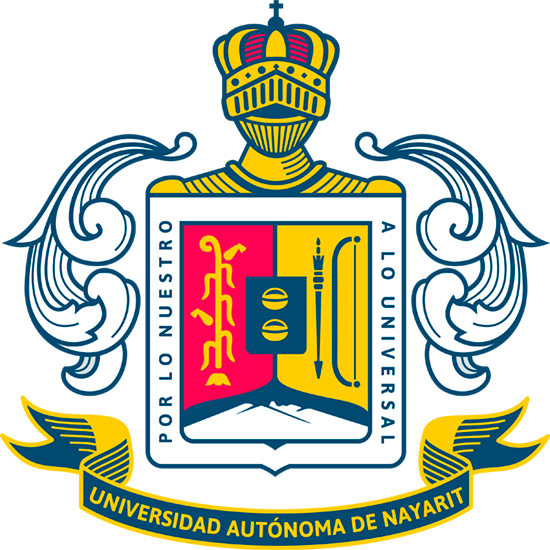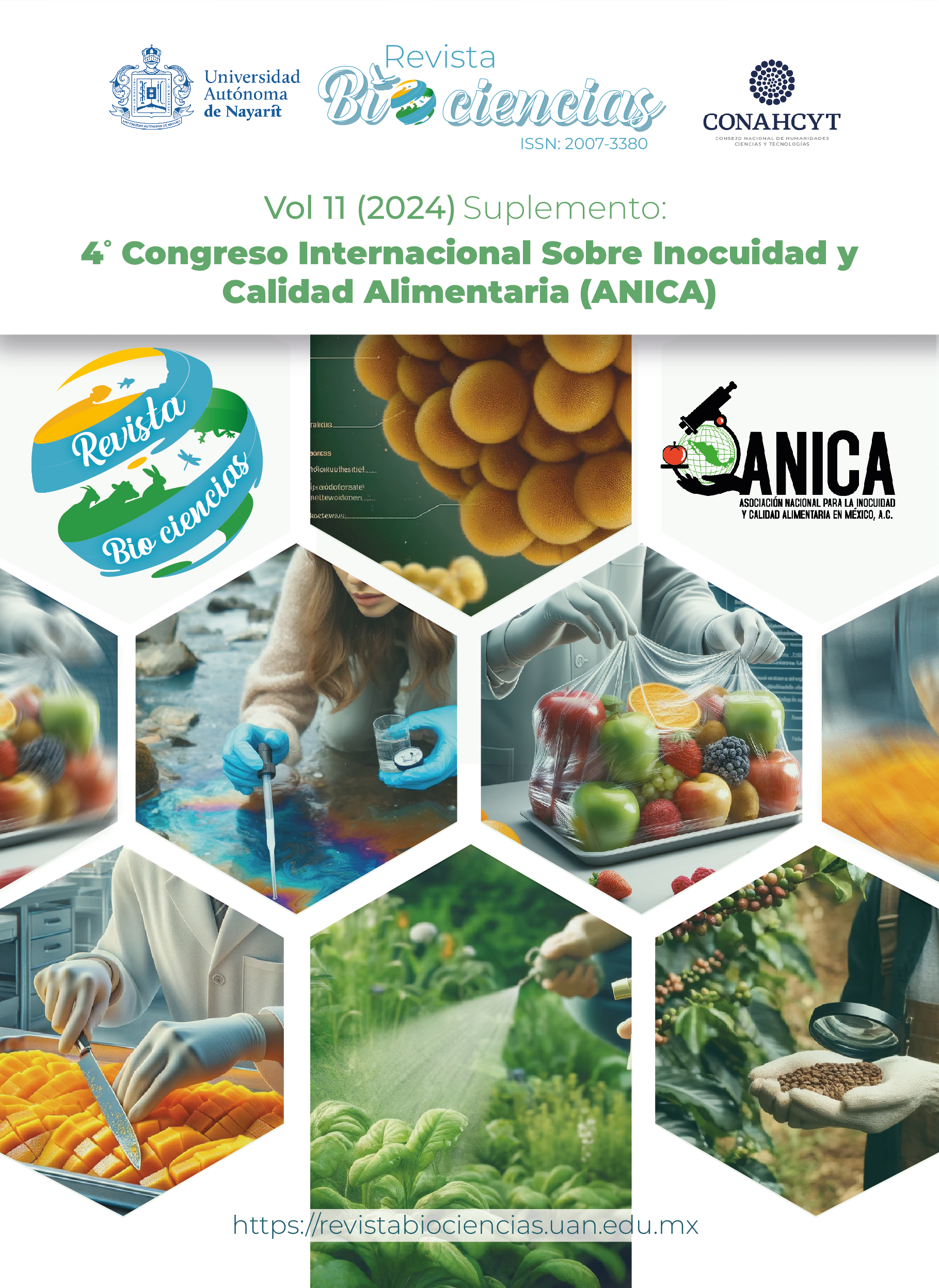Abstract
In this study, the effect of solid-state fermentation on a defatted Jatropha curcas meal with and without hydrothermal treatment was evaluated using Saccharomyces cerevisiae (6 × 109 CFU/g) and incubated for 24, 72 and 144 h at 36°C. The content of antinutrients was determined by spectrophotometric methods, the content of phorbol esters was evaluated by high-resolution thin layer chromatography, and the nutritional composition was evaluated by proximal analysis. A two-factor design (type of treatment and fermentation time) was used with response variables of the content of phytates, saponins, phorbol esters and nutritional content. The flour that had the characteristics of our interest was the one that was only fermented for 144 h without hydrothermal treatment because it presented a significant reduction of 74% of phytates, 51% of saponins, in addition to the fact that no phorbol esters were detected. The protein and ash content (44.50 and 12.52%, respectively) did not have significant changes. Additionally, a decrease in fat and fiber content was observed from 15.84 to 13.21% and from 9.29 to 5.54%, respectively. Therefore, this flour is recommended to be implemented in a balanced diet for Nile tilapia.
References
Abasubong, K. P., Gabriel, N. N., Adjoumani, J. J. Y., Okon, A. O., Udo, M. T., Etim, A. A., & Desouky, H. E. (2023). A Dynamic Study of the influence of Jatropha curcas on Growth and Haematological Indices in Finfish. In Emerging Sustainable Aquaculture Innovations in Africa, Singapore: Springer Nature Singapore, 301-323. https://doi.org/10.1007/978-981-19-7451-9_12
Achten, W. M., Nielsen, L. R., Aerts, R., Lengkeek, A. G., Kjær, E. D., Trabucco, A., Hansen, J. K., Maes, W. H., Graudal, L., & Akinnifesi, F. K. (2010). Towards domestication of Jatropha curcas. Biofuels, 1(1), 91-107. https://doi.org/10.4155/bfs.09.4
Adedayo, M. R., & Sani, A. (2019). Effect of solid state fungal fermentation on the chemical composition of Adansonia digitata seed. Covenant Journal of Physical and Life Sciences, 7(1), 11-28. (Special Edition). https://journals.covenantuniversity.edu.ng/index.php/cjplsse/article/view/1359
Ahmadifar, E., Sadegh, T. H., Dawood, M. A., Dadar, M., & Sheikhzadeh, N. (2020). The effects of dietary Pediococcus pentosaceus on growth performance, hemato-immunological parameters and digestive enzyme activities of common carp (Cyprinus carpio). Aquaculture, 516, 734656. https://doi.org/10.1016/j.aquaculture.2019.734656
AOAC. (2001). Official Methods of Analysis AOAC International Methods 934.01, 988.05, 920.39 and 942.05. In: AOAC International Arlington, VA, USA.
Csutak, O., Stoica, I., Ghindea, R., Tanase, A.M., & Vassu, T. (2010). Insights on yeast bioremediation processes. Romanian Biotechnological Letters, 15 (2), 5066-5071. https://www.researchgate.net/publication/228910865_Insights_on_yeast_bioremediation_processes
Darwish, G. A., Bakr, A., & Abdallah, M. (2012). Nutritional value upgrading of maize stalk by using Pleurotus ostreatus and Saccharomyces cerevisiae in solid state fermentation. Annals of Agricultural Sciences, 57(1), 47-51. https://doi.org/10.1016/j.aoas.2012.03.005
da Schio, B. (2010). Jatropha curcas L., a potential bioenergy crop. On field research in Belize, M.Sc. dissertation. Padua University, Italy and Wageningen University and Research Centre, Plant Research International, the Netherlands. https://docslib.org/doc/8708461/jatropha-curcas-l-a-potential-bioenergy-crop-on-field-research-in-belize
Devappa, R. K., Bingham, J.-P., & Khanal, S. K. (2013). High performance liquid chromatography method for rapid quantification of phorbol esters in Jatropha curcas seed. Industrial Crops and Products, 49, 211-219. https://doi.org/10.1016/j.indcrop.2013.04.044
Dharmakar, P., Aanand, S., Kumar, J. S. S., Ande, M. P., Padmavathy, P., & Pereira, J. J. (2022). Solid-state fermentation of sunflower meal using commercial yeast for use as an improved nutrient source in aquafeed. International Journal of Applied Research, 8(3), 375-378. https://doi.org/10.22271/allresearch.2022.v8.i3e.9590
FAO (2020). El estado mundial de la pesca y la acuicultura 2020. La sostenibilidad en acción. Organización de las Naciones Unidas para la Alimentación y la Agricultura, Roma. https://doi.org/10.4060/ca9229es
Ghosh, K., & Mandal, S. (2015). Nutritional evaluation of groundnut oil cake in formulated diets for rohu, Labeo rohita (Hamilton) fingerlings after solid state fermentation with a tannase producing yeast, Pichia kudriavzevii (GU939629) isolated from fish gut. Aquaculture Reports, 2, 82-90. https://doi.org/10.1016/j.aqrep.2015.08.006
Gomes, T. G., Hadi, S., Costa Alves, G. S., Mendonca, S., De Siqueira, F. G., & Miller, R. N. G. (2018). Current Strategies for the Detoxification of Jatropha curcas Seed Cake: A Review. Journal of Agricultural and Food Chemistry, 66(11), 2510-2522. https://doi.org/10.1021/acs.jafc.7b05691
Haraldsson, A. K., Veide, J., Andlid, T., Alminger, M. L., & Sandberg, A.-S. (2005). Degradation of phytate by high-phytase Saccharomyces cerevisiae strains during simulated gastrointestinal digestion. Journal of Agricultural and food Chemistry, 53 (13), 5438-5444. https://doi.org/10.1021/jf0478399
Hassaan, M. S., Soltan, M. A., & Abdel-Moez, A. M. (2015). Nutritive value of soybean meal after solid state fermentation with Saccharomyces cerevisiae for Nile tilapia, Oreochromis niloticus. Animal Feed Science and Technology, 201, 89-98. https://doi.org/10.1016/j.anifeedsci.2015.01.007
Hiai, S., Oura, H., & Nakajima, T. (1976). Color reaction of some sapogenins and saponins with vanillin and sulfuric acid. Planta Medica, 29(02), 116-122. https://doi.org/10.1055/s-0028-1097639
Hodar, A.R., Vasava, R.J., Mahavadiya, D.R. y Joshi, N.H. (2020). Fish meal and fish oil replacement for aqua feed formulation by using alternative sources: a review. Journal of Experimental Zoology India, 23(1), 13-21. https://www.researchgate.net/publication/338392541_FISH_MEAL_AND_FISH_OIL_REPLACEMENT_FOR_AQUA_FEED_FORMULATION_BY_USING_ALTERNATIVE_SOURCES_A_REVIEW
Krishna, C. (2005). Solid-state fermentation systems—an overview. Critical Reviews in Biotechnology, 25(1-2), 1-30. https://doi.org/10.1080/07388550590925383
Lizardi-Jiménez, M. A., & Hernández-Martínez, R. (2017). Solid state fermentation (SSF): diversity of applications to valorize waste and biomass. 3 Biotech, 7(1), 44. https://doi.org/10.1007/s13205-017-0692-y
Makkar, H., Becker, K., Sporer, F., & Wink, M. (1997). Studies on nutritive potential and toxic constituents of different provenances of Jatropha curcas. Journal of Agricultural Food Chemistry, 45(8), 3152-3157. https://doi.org/10.1021/jf970036j
Makkar, H. P., & Becker, K. (2009). Jatropha curcas, a promising crop for the generation of biodiesel and value‐added coproducts. European Journal of Lipid Science and Technology, 111(8), 773-787. https://doi.org/10.1002/ejlt.200800244
Makkar, H. P., Siddhuraju, P., & Becker, K. (2007). Phorbol esters. In Plant Secondary Metabolites, Springer, 101-105. https://doi.org/10.1007/978-1-59745-425-4_1
Martinez-Herrera, J., Siddhuraju, P., Francis, G., Davilaortiz, G., & Becker, K. (2006). Chemical composition, toxic/antimetabolic constituents, and effects of different treatments on their levels, in four provenances of Jatropha curcas L. from Mexico. Food Chemistry, 96(1), 80-89. https://doi.org/10.1016/j.foodchem.2005.01.059
Medina-Rodelo, D. P., Quintana-Obregón, E. A., Gutiérrez-Dorado, R., Heredia, J. B., Puello-Cruz, A. C., & Angulo-Escalante, M. A. (2023). The effects of solid-state fermentation of the defatted Jatropha platyphylla meal on antinutritional factors, toxic compounds, and nutritional composition. Journal of Food Measurement and Characterization, 1-12. https://doi.org/10.1007/s11694-023-02191-1
Mondal, K., & Payra, P. (2015). A review on use of plant protein sources in diets for fish feed formulation. Journal of International Academic Research for Multidisciplinary, 3(5), 257-264. https://www.jiarm.com/JUNE2015/paper23132.pdf
Moss, A. S., Ishikawa, M., Koshio, S., Yokoyama, S., & Dawood, M. A. (2019). Effects of different levels of marine snail shells in the diets of juvenile kuruma shrimps Marsupenaeus japonicus as a source of calcium. North American Journal of Aquaculture, 81(1), 55-66. https://doi.org/10.1002/naaq.10066
Ocampo, R. J., Rosales-Serna, R., González, J. A. R., Alfredo, P., & Martínez, D. (2015). Harina de Jatropha para la alimentación animal. Estado del arte en la ciencia y tecnología para la producción y procesamiento de Jatropha no tóxica. Secretaría de Agricultura, Ganadería, Desarrollo Rural, Pesca y Alimentación. Instituto Nacional de Investigaciones Forestales, Agrícolas y Pecuarias. Centro de Investigación Regional Pacífico Sur. Campo Experimental Zacatepec. Publicación Especial No. 60. pp. 74. https://gala.gre.ac.uk/id/eprint/14482/5/14482%20ATKINSON_State_of_Art_on_Science_and_Technology_2015.pdf
Olukomaiya, O. O., Fernando, W. C., Mereddy, R., Li, X., & Sultanbawa, Y. (2020). Solid-state fermentation of canola meal with Aspergillus sojae, Aspergillus ficuum and their co-cultures: Effects on physicochemical, microbiological and functional properties. Lwt, 127, 109362. https://doi.org/10.1016/j.lwt.2020.109362
Plaipetch, P., & Yakupitiyage, A. (2014). Effect of replacing soybean meal with yeast‐fermented canola meal on growth and nutrient retention of Nile tilapia, Oreochromis niloticus (Linnaeus 1758). Aquaculture Research, 45(11), 1744-1753. https://doi.org/10.1111/are.12119
Rashad, M. M., Mahmoud, A. E., Abdou, H. M., & Nooman, M. U. (2011). Improvement of nutritional quality and antioxidant activities of yeast fermented soybean curd residue. African Journal of Biotechnology, 10(28), 5504-5513. https://www.ajol.info/index.php/ajb/article/view/94330
Sharath, B. S., Mohankumar, B. V., & Somashekar, D. (2014). Bio-detoxification of phorbol esters and other anti-nutrients of Jatropha curcas seed cake by fungal cultures using solid-state fermentation. Applied Biochemistry and Biotechnology, 172(5), 2747-2757. https://doi.org/10.1007/s12010-013-0698-9
Sindhu, S. C., & Khetarpaul, N. (2001). Probiotic fermentation of indigenous food mixture: effect on antinutrients and digestibility of starch and protein. Journal of Food Composition and Analysis, 14(6), 601-609. https://doi.org/10.1006/jfca.2001.1022
Soltan, M. A., Hassaan, M. S., Abdella, M. S., El-Syaad, G. A., & El-Ashry, M. A. (2015). Yeast fermented sunflower meal as a replacer for fish meal in diets of the Nile tilapia, Oreochromis niloticus. Egyptian Journal of Aquatic Biology and Fisheries, 287(2394), 1-9. https://doi.org/10.21608/ejabf.2015.2258
Tanasković, S. J., Šekuljica, N., Jovanović, J., Gazikalović, I., Grbavčić, S., Đorđević, N., Sekulić, M. V., Hao, J., Luković, N., & Knežević-Jugović, Z. (2021). Upgrading of valuable food component contents and anti-nutritional factors depletion by solid-state fermentation: A way to valorize wheat bran for nutrition. Journal of Cereal Science, 99, 103159. https://doi.org/10.1016/j.jcs.2020.103159
Terefe, Z. K., Omwamba, M. N., & Nduko, J. M. (2021). Effect of solid state fermentation on proximate composition, antinutritional factors and in vitro protein digestibility of maize flour. Food Science & Nutrition, 9(11), 6343-6352. https://doi.org/10.1002/fsn3.2599
Vaintraub, I. A., & Lapteva, N. A. (1988). Colorimetric determination of phytate in unpurified extracts of seeds and the products of their processing. Analytical Biochemistry, 175(1), 227-230. https://doi.org/10.1016/0003-2697(88)90382-X
Van-Doan, H., Hoseinifar, S. H., Ringø, E., Ángeles-Esteban, M., Dadar, M., Dawood, M. A., & Faggio, C. (2020). Host-associated probiotics: a key factor in sustainable aquaculture. Reviews in Fisheries Science & Aquaculture, 28(1), 16-42. https://doi.org/10.1080/23308249.2019.1643288
Vásquez-Villalobos, V. J., Rojas-Padilla, C. R., Luján-Velásquez, M. N., Cholán-Rodríguez, M. A., Mercedes-Chávez, L. A., & Vásquez-Angulo, J. D. (2019). Evaluación de digestibilidad proteica in vivo e in vitro utilizando Saccharomyces cerevisiae (Saccharomycetaceae) como organismo modelo. Arnaldoa, 26(3), 1125-1142. http://www.scielo.org.pe/pdf/arnal/v26n3/a18v26n3.pdf

Revista Bio Ciencias by Universidad Autónoma de Nayarit under Creative Commons Attribution-NonCommercial 3.0 Unported License.
Based on work of http://biociencias.uan.edu.mx/.
Further permits not covered by this licence can be found at http://editorial.uan.edu.mx/index.php/BIOCIENCIAS.






